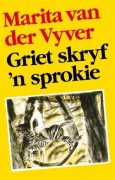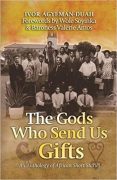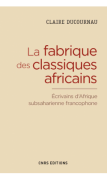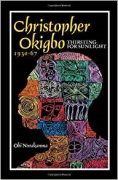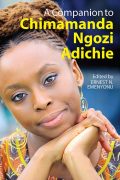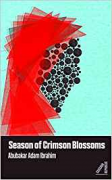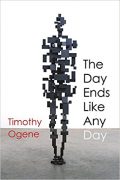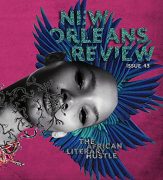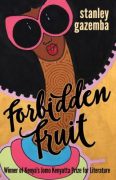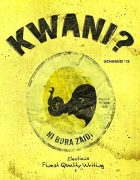Griet skryf ‘n sprokie – Eendag was daar ’n sosiaal kritiese en hermafrodiete heks | Lieselot Tuytens
Griet skryf ’n sprokie is in een notendop het verhaal van een schrijfster met een identiteitscrisis. Die innerlijke worsteling wordt veroorzaakt door een stukgelopen huwelijk, en een lange reeks vruchteloze zwangerschappen, die de protagonist Griet Swart tot een zelfmoordpoging drijven. Haar suïcide, geïnspireerd op de CO-vergiftiging door de oven van de Amerikaanse dichteres Sylvia Plath, mislukt echter. Dat komt niet door de redding door de prins op het witte paard waarvan ze droomt, maar door de lugubere ontdekking van een dode kakkerlak in de oven die haar doet terugdeinzen. Die atypische en anekdotische korte inhoud van Marita van der Vyvers bestseller uit 1992 trok meteen mijn aandacht voor het werk van de Zuid-Afrikaanse auteur (1958). Aan het begin van haar carrière combineerde de romancière uit Kaapstad het schrijverschap met een journalistieke loopbaan als verslaggeefster bij het dagblad Die Burger en het vrouwentijdschrift Sarie. Vanaf 1987 werd ze freelanceschrijfster en -vertaalster, waardoor ze meer tijd had om haar eigen oeuvre vorm te geven (Van Coller 2007:481).
Hoog op de agenda in Griet skryf ’n sprokie staat humor, hoewel door de personages met lede ogen wordt aangezien hoe de “snaakse Afrikaanse roman” op sterven na dood is: “Die hele wêreld is in oproer oor die walvis ’n bedreigde spesie geword het. Fok die walvis, sê ek. Laat ons liewer worry oor laggende Suid-Afrikaners ’n bedreigde spesie geword het” (Van der Vyver 1992:77-78). Komisch is Van der Vyvers roman dus zeker, maar toch is het werk zoveel meer dan een zonderlinge en lachwekkende historie. Achter de tragikomische inhoud en humoristische stijl van Griet skryf ’n sprokie gaat namelijk een maatschappijkritische boodschap schuil, die patriarchale opvattingen over gender, moraliteit en politiek uit het twintigste-eeuwse Zuid-Afrika ter discussie stelt. Die bijgestelde waarden corresponderen met het nieuwe tijdperk van post-apartheid dat het land ingaat. Met dit doel incorporeert en transformeert Marita van der Vyver het in de romantitel vermelde sprookjesgenre en daarenboven meer dan twintig specifieke sprookjes uit de omvangrijke Duitse sprookjescollectie van de gebroeders Grimm, uitgegeven in de negentiende eeuw onder de naam Kinder- und Hausmärchen. Beide bronnen lenen zich goed tot hervorming door hun conservatieve strekking met betrekking tot de drie eerder aangehaalde domeinen.
De theorie: (postmoderne) intertekstualiteit
De maatschappijkritiek wordt door Marita van der Vyver ingebed in de populaire verhalen om die minder nadrukkelijk en prekerig op de voorgrond te laten treden. Hiervoor maakt ze gebruikt van de literaire techniek van de intertekstualiteit, die al eeuwenoud is, maar pas in 1960 haar benaming kreeg van de Franse linguïste Julia Kristeva. Het begrip kent evenveel definities als er onderzoekers zijn (Orr 2003:6), maar omvat in feite volgens het onlinewoordenboek De Dikke Van Dale (2018) “het verschijnsel dat literaire teksten verweven zijn en verwijzingen naar andere (literaire) teksten bevatten.” Belangrijk hierbij is dat de techniek een dubbele werking heeft van enerzijds imitatie en anderzijds transformatie.
Die opvatting draagt ook de Vlaamse classicus Paul Claes (1943) hoog in het vaandel in zijn intertekstualiteitstheorie, die de basis vormde van het masteronderzoek dat ik in 2017-2018 voerde naar de generische en specifieke sprookjesverwijzingen in Griet skryf ’n sprokie. In zijn boek uit 2011, Echo’s echo’s: de kunst van de allusie, stelt hij namelijk dat er een metamorfose plaatsvindt “van grondtekst naar eindtekst”, die hij later benoemt als de “architekst” en “fenotekst” (2011:35-36, 52). Om die modificaties van de oude tekst in de nieuwe op te sporen, introduceert hij onderstaande tabel met vier mogelijke procedés: “additie, deletie, substitutie en repetitie” (2011:54). Die toevoeging, weglating, vervanging of herhaling kunnen zowel van toepassing zijn op de vorm of de inhoud van de tekst als op de combinatie van beide en leiden zo tot twaalf mogelijke transformaties, waarvan de allusie en het citaat de bekendste zijn.

Naast het blootleggen van die wijzigingen in de fenotekst zet Claes ook in op de verklaring ervan. De betekenis of functie moet volgens hem door de lezer of het subject achterhaald en toegeschreven worden aan de tekst, zoals blijkt uit zijn definitie van intertekstualiteit: “Het geheel van relaties tussen teksten waaraan door een subject dat deze onderkent een functie kan worden toegekend” (Claes 2011:49). Zelf onderscheidt hij twee functies, die respectievelijk een positieve of negatieve houding weerspiegelen ten opzichte van de architekst of fenotekst, de “constructieve” en “destructieve functie” (2011:56). Er zijn echter nog veel andere mogelijke functies, waarvan Yra Van Dijk en Maarten De Pourcq in Draden in het donker: intertekstualiteit in theorie en praktijk (2013) een overzicht bieden. Zij spreken evenwel over effecten, aangezien die gecreëerd worden door de uitwerking van de tekst op de lezer en niet zoals functies bewust geïnstalleerd worden door de auteur zelf (2013:10). Ze stellen er vijf voor, waarvan de structurerende, de satirische en de feministische de belangrijkste zijn (2013:9). Het structurerende effect veronderstelt dat de overgenomen architekst indicaties kan geven van de “verborgen structuur in de roman” of fenotekst (2013:9). Het satirische effect omvat een spottende attitude van de fenotekst tegenover de architekst (2013:9). Bij het feministische effect, ten slotte, dienen de transformaties van de architekst in de fenotekst de feministische ideologische agenda (2013:9).
Behalve de intertekstuele verwijzingen kwamen ook de postmoderne eigenschappen ervan aan bod, omdat Van der Vyvers oeuvre volgens H. P. Van Coller (2007:485) bekend staat om de gehanteerde “postmodernistiese denkbeelde en tegnieke”. Net zoals intertekstualiteit doelt de postmoderne pendant op het bekritiseren van de architekst en het verstoren van het westerse homogene wereldbeeld dat daarin vervat zit (Hutcheon 1985:80-81, 2005:179) . Daartoe worden technieken gehanteerd zoals taboedoorbreking, parodie, genrevermenging, metafictie, en excessieve fictionaliteit en narrativiteit (Vervaeck 2014a:72). Het openlijk aankaarten van taboes, het kritisch bejegenen van de oude én de nieuwe tekst via parodie, en de vertroebeling van de grens tussen ‘elitaire’ en ‘populaire’ genres zijn veel voorkomende kenmerken van postmoderne intertekstualiteit. Daarnaast wordt er door metafictie op metaniveau gereflecteerd over fictie, waardoor ook de scheidingslijn tussen fictie en realiteit minder duidelijk wordt. Verder worden het fictieve en verhalende karakter van de postmoderne roman extra in de verf gezet door de evocatie van een netwerk van bestaande vertellingen.
Zowel intertekstualiteit als postmoderne intertekstualiteit werden als theoretisch kader gehanteerd om een antwoord te bieden op drie vragen, opnieuw ontleend aan Paul Claes: “een wat-vraag, een hoe-vraag en een waarom-vraag” (1984:32). Als eerste werd onderzocht welke componenten wel of niet overgenomen werden uit de generische en specifieke interteksten in Griet skryf ’n sprokie. Vervolgens werd nagegaan hoe die geïncorporeerde interteksten getransformeerd werden. Ten slotte ging het onderzoek in op de betekenissen van die modificaties, die gekarakteriseerd werden aan de hand van hun functies of effecten.
De praktijk: de transformatie
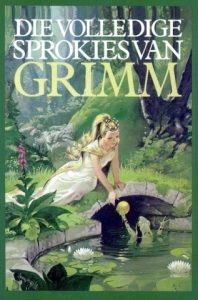 Nu de wellicht abstracte, maar noodzakelijke theorie achter de rug is, kan ze geconcretiseerd worden door over te schakelen op de praktijk. Enkele voorbeelden van de toepassing van (postmoderne) intertekstualiteit op Griet skryf ’n sprokie worden besproken, net als de resultaten die dat heeft opgeleverd, zowel wat het sprookjesgenre betreft als één uitgelicht sprookje van Grimm, met name Doornroosje.
Nu de wellicht abstracte, maar noodzakelijke theorie achter de rug is, kan ze geconcretiseerd worden door over te schakelen op de praktijk. Enkele voorbeelden van de toepassing van (postmoderne) intertekstualiteit op Griet skryf ’n sprokie worden besproken, net als de resultaten die dat heeft opgeleverd, zowel wat het sprookjesgenre betreft als één uitgelicht sprookje van Grimm, met name Doornroosje.
Op generisch vlak werden de microstructuur, de macrostructuur, en de belangrijkste personages en rollen die ze aannamen onder de loep genomen in Van der Vyvers roman. Daarna werden die drie onderdelen vergeleken met de stand van zaken in het traditionele sprookje, zoals in kaart gebracht door Jack Zipes (1991, 2000, 2006), Maria Tatar (1987) en Gunther Pakendorf (1992). De geselecteerde casus situeert zich op het niveau van de microstructuur en omvat één specifieke episode uit het verhaalverloop: de transformatie.
Volgens Zipes (2000:xvii-xviii) ligt de essentie van het sprookjesgenre in de evolutie die de protagonist doormaakt nadat die door omstandigheden uit zijn vertrouwde familiekring wordt weggerukt. De hoofdfiguur leert zo op eigen benen te staan en gaat op zoek naar zijn identiteit. Die metamorfose gaat vaak gepaard met de groei van zijn sociale mobiliteit, zoals in de typische ‘Rags to riches’ verhalen waarin een vagebond zich ontpopt tot welgestelde prins, hoewel de transformatie van velerlei aard kan zijn (Zipes 2000:xvii-xviii). Toch vormt de gedaanteverwisseling de gemeenschappelijke kern van alle sprookjes, aangezien ze onontbeerlijk is voor de held om te overleven. Dat is letterlijk het geval voor Griet, die haar zelfmoordneigingen voortdurend moet onderdrukken en omdat haar kentering ligt in de genezing van haar depressie. Die overeenkomst wijst op een constructieve allusie op of inhoudelijke herhaling van de sprookjesepisode, omdat Griets levensloop geënt is op de structuur van het klassieke sprookjesgenre (Claes 2011:55-56). Tot zover wordt het basispatroon dus grotendeels overgenomen.
Desondanks krijgt de transformatie een unieke invulling, want Van der Vyver verbindt de persoonlijke ervaring van haar protagonist met het parallelle proces dat Zuid-Afrika doorloopt. Van Coller (2007:482) spreekt naar aanleiding hiervan over “die interaksie tussen persoonlike traumas en die politiek-ideologiese situasie in Suid-Afrika” als een hoofdkenmerk van haar oeuvre. Niet enkel Griet zet een nieuwe koers in, zich verwijderend van de lonkende oven, maar ook het land geneest van de officiële rassensegregatie, die geschetst wordt aan de hand van een ziektebeeld. Er is namelijk een samenloop van Griets psychische bevrijding met die van Nelson Mandela en Zuid-Afrika uit de klauwen van het apartheidsregime in 1990 (Van Coller 2007:486). Zo vermeldt Griet Mandela vaak rechtstreeks, maar soms maakt ze ook subtielere toespelingen op de gelijklopende politieke situatie, bijvoorbeeld wanneer ze na het verlies van haar huis door een echtscheiding haar nieuwe woning betreedt. Ze maakt dan de metaforische vergelijking met een gevangene die bijna vrijgelaten wordt, doelend op Mandela en zijn jarenlange opsluiting op Robbeneiland in de Victor Verster Prison, die bijna ten einde komt: “[…] ek voel baie beter vandat ek eergister my eie woonstel gekry het – soos ’n gevange wat weet haar tronkstraf is amper verby!” (Van der Vyver 1992:121). Volgens Pakendorf (1992) “[…] word die verhaal van Griet se ontreddering in ’n sekere sin ook ’n metafoor vir die nagmerrie wat hierdie ‘veelkleurige land’ teselfdertyd beleef.” Die inhoudelijke additie van de staatkundige context resulteert in Claes’ termen (2011:54) in een “uitdieping” van het sprookje, dat zich normaliter niet inlaat met het politieke landschap, maar focust op de wereld van de magie. De toevoeging heeft een constructieve functie, want het genre wordt opengetrokken door het te vermengen met serieuze materie, die gewoonlijk toebehoort aan een meer ‘elitair’ genre zoals het ideologisch traktaat. Daardoor wordt aangetoond dat er ook een diepere betekenis en politiek engagement kunnen schuilgaan achter de zogenaamde kinderverhalen. De architekst wordt bijgevolg opgewaardeerd door er in de fenotekst nieuwe waarden aan toe te kennen en er een kritische insteek aan te geven.
De praktijk: Doringrosie
Wat de specifieke interteksten aangaat, kwamen er veertien sprookjes van Grimm aan bod, waaronder het alom bekende Assepoester en Hans en Grietje, maar ook minder vermaarde vertellingen zoals De twaalf jagers en Het kind van Maria. De verwijzingen naar deze verhalen in Griet skryf ’n sprokie werden vergeleken met de tekstfragmenten uit de Afrikaanse vertaling van het Duitse origineel door Marita van der Vyver uit 2007, Die volledige sprokies van Grimm. Door het gebruik van die versie konden de vormelijke metamorfoses gemakkelijker opgespoord worden, omdat de taal van de architekst en de fenotekst dezelfde is.
Terwijl bij de transformatie uit het sprookjesgenre vooral wordt ingezet op het politieke domein, verschuift de focus bij het specifieke sprookje Doornroosje, of in het Afrikaans Doringrosie, naar gender-gerelateerde en morele kwesties. Het verhaal wordt namelijk over een heel andere en erotische boeg gegooid, wat voor heel wat controverse zorgde in het twintigste-eeuwse Zuid-Afrika. Van Coller (2007:485) beschreef Van der Vyvers roman daarom dan ook als “’n werk wat die behoudende Afrikaanse literêre wêreldjie tot in sy fondamente skok.”
De seksualisering van het sprookje begint al bij de hoofdstuktitel van het achtste kapittel uit Griet skryf ’n sprokie, die als volgt luidt: Doringrosie sukkel om te slaap (Van der Vyver 1992:50). Die titel vormt door middel van een humoristische wending een parodie op Doringrosie, omdat de gelijknamige protagonist in Grimms versie juist 100 jaar slaapt. De verdraaiing of inhoudelijke substitutie heeft daardoor een satirisch effect en ze wordt gebruikt om het probleem rond vrouwelijke masturbatie aan te kaarten. Griet identificeert zich namelijk met Doornroosje, maar kan de slaap niet vatten omdat haar naaktheid haar seksuele driften losmaakt: “En omdat sy vanaand kaal is, dink sy aan seks” (Van der Vyver 1992:50). Ze bevredigt haar eigen lusten, maar stelt dat masturbatie enkel geaccepteerd wordt bij mannen, terwijl het bij vrouwen een taboe blijft:
Maar vir Griet en al haar ordentlike susters was seks ’n dubbelpad waarvan jy amper per ongeluk na die eenspoorpaadjie van masturbasie afgedwaal het – nie andersom nie. (Van der Vyver 1992:51)
De vervanging heeft verder ook een feministisch effect, omdat ze – zoals dat in postmoderne en feministische werken ook gebeurt – speelt met taboes over vrouwelijke seksualiteit en zelfbevrediging, die normaliter gebannen worden uit sprookjes (Hutcheon 1989:152). Door zulke gevoelige onderwerpen aan te snijden, wil Marita van der Vyver ze, met haar hoofdpersonage als spreekbuis, normaliseren en het taboe doorbreken waarmee ze gewoonlijk geassocieerd worden. Bovendien verstoort ze ook het stereotiepe en patriarchale ideaalbeeld van de vrouw als passieve en zedelijke engel in het huishouden door Griet dezelfde rechten als mannen te verlenen en haar een actieve seksuele rol aan te meten (Gilbert en Gubar 1984:20). Op die manier kunnen postmoderne technieken, waaronder intertekstualiteit en parodie, de verstikkende effecten van sprookjes op de vrouwelijke identiteit bestrijden en de preutse prinsessen omvormen tot sterke en stoutmoedige heldinnen (Zipes 2000:157, Stone 2014:229-30).
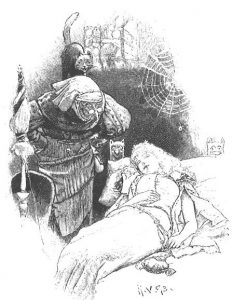 Daarnaast actualiseert Van der Vyver de architekst Doringrosie door het beruchte “vigs-motief” onder de aandacht te brengen, dat frequent opduikt in de Zuid-Afrikaanse literatuur (Van Coller 2007:485). Het ‘verworwe immuniteitsgebreksindroom’, beter bekend als aids, boezemt de protagonist Griet veel angst in, aangezien ze het beschrijft als “’n monster wat Jaws soos ’n goudvissie laat lyk” (Van der Vyver 1992:53). Net als masturbatie is het een taboeonderwerp, want ze bestempelt het als een vloekwoord (Van der Vyver 1992:51). Die beschouwing leidt haar ertoe om de geslachtsziekte te verbinden met de vloek die Doringrosie treft in het gelijknamige sprookje.
Daarnaast actualiseert Van der Vyver de architekst Doringrosie door het beruchte “vigs-motief” onder de aandacht te brengen, dat frequent opduikt in de Zuid-Afrikaanse literatuur (Van Coller 2007:485). Het ‘verworwe immuniteitsgebreksindroom’, beter bekend als aids, boezemt de protagonist Griet veel angst in, aangezien ze het beschrijft als “’n monster wat Jaws soos ’n goudvissie laat lyk” (Van der Vyver 1992:53). Net als masturbatie is het een taboeonderwerp, want ze bestempelt het als een vloekwoord (Van der Vyver 1992:51). Die beschouwing leidt haar ertoe om de geslachtsziekte te verbinden met de vloek die Doringrosie treft in het gelijknamige sprookje.
In Grimms verhaal houdt de koning een groot feest ter gelegenheid van de geboorte van zijn dochter. Hij nodigt zijn hele familie uit, alsook vrienden en de wijze feeën, zodat die de prinses kunnen beschermen en zegenen met geschenken (Grimm 1857, geciteerd naar Van der Vyver 2007:122). Bij gebrek aan voldoende gouden borden voor de dertien feeën bij het diner wordt er één niet geïnviteerd. Tijdens de zegeningen verschijnt de dertiende fee toch nog en ze neemt wraak door de prinses te vervloeken tot de dood. Die vloek zal ingaan als ze zich in haar vijftiende levensjaar aan een spinnenwiel prikt (Grimm 1857, geciteerd naar Van der Vyver 2007:122). De tragedie wordt afgewend door de twaalfde fee, die nog geen wens had uitgesproken voor de prinses en de doodstraf wijzigt naar een 100 jaar durende slaap (Grimm 1857, geciteerd naar Van der Vyver 2007:122, mijn onderstreping).
 In Griet skryf ’n sprokie wordt er gealludeerd op dat patroon, maar er is een verdraaiing van de vloek. Het sprookje wordt geseksualiseerd, want Griet schildert de dertiende fee af als een jaloerse maagd en de doodstraf door het spinnenwiel wordt gesubstitueerd door aids ten gevolge van geslachtsgemeenschap:
In Griet skryf ’n sprokie wordt er gealludeerd op dat patroon, maar er is een verdraaiing van de vloek. Het sprookje wordt geseksualiseerd, want Griet schildert de dertiende fee af als een jaloerse maagd en de doodstraf door het spinnenwiel wordt gesubstitueerd door aids ten gevolge van geslachtsgemeenschap:
Niemand het meer duiwels nodig nie. Die vrees vir Aids het elke sondaar se eie hel geword. Dís die vloek wat die dertiende fee oor die moderne mensdom uitgespreek het. ’n Afgunstige maagd wat sterflinge wou straf waar dit die seerste maak: seks, wat aardbewoners van feë onderskei. In die laaste twee dekades voor die jaar tweeduisend, het hierdie bose fee bepaal, sal seks ’n gevaarliker wapen word as wat die spinwiel ooit was. (Van der Vyver 1992:53, mijn onderstreping)
Op dit punt gaat er in Doringrosie 100 jaar voorbij, waarna de prinses gewekt wordt door de kus van een sprookjesprins, die de vloek verbreekt. Van der Vyvers versie kent daarentegen een heel verschillende afloop: Griet neemt de rol van Doringrosie op zich, maar moet niet rekenen op een redder. Die inhoudelijke deletie of afvlakking heeft een feministisch effect als gevolg, want Griet moet zichzelf behelpen door masturbatie omdat de vloek niet opgeheven wordt en aids een gevaarlijk risico blijft:
En hierdie keer sal Doringrosie haarself maar moet red. Met haar eie hande. Wat bly oor, behalwe hoop en masturbasie? (Van der Vyver 1992:53, mijn onderstreping)
Op basis van de generische en specifieke casussen kunnen we dus besluiten dat sprookjes in Griet skryf ’n sprokie intertekstueel ingezet en getransformeerd worden om de rigide mentaliteit en het hokjesdenken betreffende politiek, gender en moraliteit te bestrijden. Die drievoudige maatschappijkritiek wordt geformuleerd door de onconventionele, androgyne, maar sterke heldin Griet Swart: ‘’n sosiaal kritiese en hermafrodiete heks’.
Bibliografie
Claes, P. (1984). De mot zit in de mythe. Hugo Claus en de oudheid. Amsterdam: De Bezige Bij.
Claes, P. (2011). Echo’s echo’s. De kunst van de allusie. Nijmegen: Vantilt.
Gilbert, S. M. & S. Gubar (1984). The Madwoman in the Attic. The Woman Writer and the Nineteenth-Century Literary Imagination. Repr. New Haven (Conn.): Yale University Press.
Grimm, J. & W. Grimm (1857). Kinder-und hausmärchen. (7e dr.). Göttingen: Dieterichsche Buchandlung.
Hutcheon, L. (1985). A Theory of Parody. the Teachings of Twentieth-Century Art Forms. New York (N.Y.): Methuen.
Hutcheon, L. (1989). The Politics of Postmodernism. Londen: Routledge.
Hutcheon, L. (2005). A Poetics of Postmodernism. History, Theory, Fiction. New York (N.Y.): Routlegde.
Intertekstualiteit. (2018). In Dikke Van Dale online woordenboek. Geraadpleegd op 12 mei 2018 via http://vandale.ugent.be/.
Orr, M. (2003). Intertextuality. Debates and Contexts. Cambridge: Polity Press.
Pakendorf, G. (1992). ‘Politiek, werklikheid en seks – as ’n sprokie’. Die Suid-Afrikaan, juni/juli 1992.
Stone, K.F. (2014). ‘Feminist Approaches to the Interpretation of Fairy Tales’. In: Bottigheimer, R. B. (red.), Fairy Tales and Society. Illusion, Allusion, and Paradigm. Pennsylvania: University of Pennsylvania Press, 229-236.
Tatar, M. (1987). The Hard Facts of the Grimms’ Fairy Tales. Princeton (N.J.): Princeton University Press.
Van Coller, H.P. (2007). ‘Marita van der Vyver (1958-)’. In: Van Coller, H.P. (red.), Perspektief & Profiel. ‘n Afrikaanse literatuurgeskiedenis. Pretoria: Van Schaik, 481-506.
Van der Vyver, M. (1992). Griet skryf ’n sprokie. 3e dr. Kaapstad: Tafelberg.
Van der Vyver, M. (2007). Die volledige sprokies van Grimm. 2e dr. Pretoria: Protea Boekhuis.
Van Dijk, I. & M. de Pourcq (2013). ‘Voorwoord’ In: Van Dijk, I., M. de Pourcq & C. De Strycker (red.), Draden in het donker. Intertekstualiteit in theorie en praktijk. Nijmegen: Vantilt, 7-14.
Vervaeck, B. (2014a). ‘Genre in verandering. Vernieuwingen in de naoorlogse Nederlandstalige roman’. Spiegel der letteren 56 (1), 51-83.
Zipes, J. (1991). Fairy Tales and the Art of Subversion. The Classical Genre for Children and the Process of Civilization. New York (N.Y.): Routledge.
Zipes, J. (2000). The Oxford Companion to Fairy Tales. Oxford: Oxford University Press.
Zipes, J. (2006). Why Fairy Tales Stick. The Evolution and Relevance of a Genre. New York (N.Y.): Routledge.
Met dank aan het Zuid-Afrikahuis (Amsterdam).
Lieselot Tuytens (Ghent University)
This article was published in: Africa Book Link, Fall 2018: Afrikaans Literature

